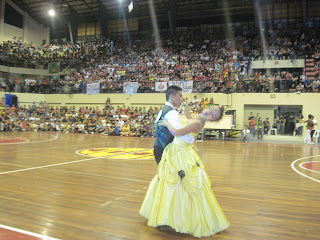Pasigin is a fish net used by the Capiznon. In the hands of a skilled fishermen, a pasigin assures food for the family. The playful imagination of the Filipinos created the pasigin dance. Using movements of excited fishermen scooping after schools of fish, intricate footwork and dexterous swishing, swashing, scooping, and sifting gave the pasigin that chase and run character. The pasigin dance would have been an ordinary and playful dance had it not been for a comic relief where at the end, the ring-net reveals a hole big enough for the fish to escape.
i lOvE VeSh
Lunes, Oktubre 17, 2011
PASIGIN DANCE
Pasigin is a fish net used by the Capiznon. In the hands of a skilled fishermen, a pasigin assures food for the family. The playful imagination of the Filipinos created the pasigin dance. Using movements of excited fishermen scooping after schools of fish, intricate footwork and dexterous swishing, swashing, scooping, and sifting gave the pasigin that chase and run character. The pasigin dance would have been an ordinary and playful dance had it not been for a comic relief where at the end, the ring-net reveals a hole big enough for the fish to escape.
BADJAO TRIBE
BADJAO
The Badjao are popularly known as "Sea Gypsies" of the Sulu and Celebes Sea. The name "Badjao" is a Malay-Bornean word which connotes "man of the seas" or Orang-Laut in Bahasa Malayo. Their Sama and Tausug neighbors call them by pejorative names such as Samal Palau (outcast Samal). The badjao call themselves as Samal Laus (Sea Sama). Many badjaos live most of their lives in houseboats, which occasionally cluster in moorings near certain strands and beaches, so as to do business in nearby market places of the land-dwelling Sama and Tausug. In the markets they barter their sea products for such farm produce as fruits and cassava. On the shore they also fetch drinking water, gather firewood and gather materials needed in the construction and repair of their houseboats.
The Badjao or sea gypsies inhabit the shores and waters of Sulu archipelago. These groups of Badjaos may be classified according to lifestyle.The badjao inhabiting Siasi Island are semi-sedentary, building stilt-houses over the water and engaging in fishing. The group of the Sitangkai builds permanent homes on the shore while the group live in the houseboat called sakayan. The stilt-houses merely serve as a temporary refuge during the time that their boathouses undergo repairs. The other boats are called lipa, vinta, pelang and kumpit.
The Badjaos are found in many coastal settlements dotting the Sulu archipelago, particularly in Jolo, Tawi-Tawi and Sitangkai. Others are scattered in Davao, Surigao, Zamboanga, Basilan, Bohol, Cebu and Manila in search of livelihood. They are estimated to be 191,817 (OSCC,1987). Their physical features are distinctively attributable to their environment and their mode of life. They have sturdy built dark brown skin and bronze hair. Their manner of walking is affected to a large extent by their crouching on boat stern while sailing or fishing.
The Badjaos are oppressed tribe. They are referred to as palao or lumaan (God forsaken) by the Tausugs. Badjaos developed an inferiority attitude towards the Tausugs and the Samals who always look down on them. Originally, they used to live on the land but the constant pressure on their safety by the other Muslim tribes forced them to seek the sea. They eventually found that the sea afforded them greater avenues of escape in the event of attack.
The sea environment shaped Badjao attitude. They learned to exploit the sea to their fullest advantage. Their prowess is in fishing, raising seaweeds and oyster. Pearl gathering is another occupation, and products of the sea they gather to sell at market.
Sabado, Oktubre 15, 2011
Mag-subscribe sa:
Mga Komento (Atom)
















